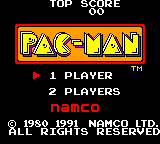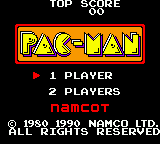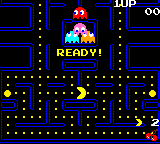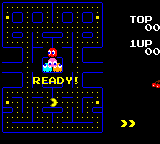Pac-Man
From Sega Retro
| ||||||||||||||||||||
| Pac-Man | ||||||||||||||||||||
|---|---|---|---|---|---|---|---|---|---|---|---|---|---|---|---|---|---|---|---|---|
| System(s): Sega Game Gear | ||||||||||||||||||||
| Publisher: Namco (JP), Namco Hometek (US), Majesco Sales (US; re-release) | ||||||||||||||||||||
| Developer: Namco | ||||||||||||||||||||
| Peripherals supported: Gear-to-Gear Cable | ||||||||||||||||||||
| Genre: Action[1] | ||||||||||||||||||||
| Number of players: 1-2 | ||||||||||||||||||||
| ||||||||||||||||||||
|
Pac-Man (パックマン) is a 1980 arcade game developed by Namco. It became incredibly successful to the point that it saw ports to consoles of the time and continues to see ports — made in-house, officially licensed, and homebrew — to today's systems. The only port of the game to a Sega system, however, was an in-house port to the Sega Game Gear in late 1990 (consequently, it was released early 1991).
On an interesting note, Sega's 1982 arcade game Ali Baba and 40 Thieves runs on modified Pac-Man hardware.
Contents
Gameplay
The basic goal of Pac-Man is to eat all the dots (or pellets) in a maze, avoiding ghosts. Pac-Man will automatically move forward in the direction that the D-Pad is pressed until he reaches a wall, but can freely change direction by pressing a different direction. By eating one of four Power Pellets in the corners of the maze, all of the ghosts will become frightened and turn blue, Pac-Man is able to eat the ghosts as well for a short period to earn bonus points. Ghosts start from a "ghost house" in the center of the maze and will respawn from the center of the screen after being eaten.
Levels are completed once all the dots are eaten, and extra points can be achieved by eating fruit that periodically appears beneath the ghost house. As the player progresses further through each level, the game's speed increases and the Power Pellets get less effective at making the ghosts vulnerable. Every few levels the game will display brief, comical cutscenes featuring Pac-Man and Blinky. The game ends when all lives are lost from being caught by the ghosts.
Unlike other versions of the game, the 2-player mode is a competitive mode where players play four rounds and compete to score the most points without running out of lives. When setting up a game, both players can decide which rounds they'll play and how many lives they start out with. The winning player is determined based on the score when either player completes all four rounds - in a tie for score, the player who cleared all four rounds first is declared the winner. The game will also end if a player runs out of lives with the surviving player being declared the winner, and the winner will be decided by score if both players run out of lives simultaneously.
Ghosts
Each of the four ghosts have a specific quirk in their AI and will pursue Pac-Man differently from one another:
| Blinky | |
|---|---|
|
Character: Shadow | |
| Blinky is always the first ghost out and will chase Pac-Man directly. After a certain number of dots are eaten, he will receive a boost in speed. | |
| Pinky | |
|
Character: Speedy | |
| Pinky targets the four tiles in front of Pac-Man, attempting to ambush him. | |
| Inky | |
|
Character: Bashful | |
| Inky's movement is relative to both Pac-Man and Blinky's. He will try to position himself in front of Pac-Man, but will give chase if Blinky is close to Pac-Man. | |
| Clyde | |
|
Character: Pokey | |
| Clyde alternates between trying to chase Pac-Man when far away, and largely ignoring him if he is close to him. |
Scoring
Dots: 10 points
Power Pellets: 50 points
Ghosts: Various points depending on how many are eaten with a single Power Pellet:
- 1st ghost: 200 points
- 2nd ghost: 400 points
- 3rd ghost: 800 points
- 4th ghost: 1,600 points
Fruit: Various points depending on the fruit:
- Cherry: 100 points
- Strawberry: 300 points
- Orange: 500 points
- Apple: 700 points
- Melon: 1,000 points
- Galaxian: 2,000 points
- Bell: 3,000 points
- Key: 5,000 points
An extra life is awarded at 10,000 points.
Versions
The Game Gear version of the game is relatively faithful, though due to the smaller resolution, graphics are smaller in size and the full maze cannot be shown without scrolling. This problem can be addressed by pressing ![]() or
or ![]() on the title screen to select a 1/2 screen size where the graphics are drawn smaller but the full maze is displayed at once. This feature is also shared with the Game Boy, Game Boy Color and Game Boy Advance versions of the game.
on the title screen to select a 1/2 screen size where the graphics are drawn smaller but the full maze is displayed at once. This feature is also shared with the Game Boy, Game Boy Color and Game Boy Advance versions of the game.
Magazine articles
- Main article: Pac-Man/Magazine articles.
Promotional material
also published in:
- Electronic Gaming Monthly (US) #27: "October 1991" (1991-xx-xx)[4]
- GamePro (US) #29: "December 1991" (1991-xx-xx)[5]
Physical scans
| Sega Retro Average | |||||||||||||||||||||||||||||||||||||||||||||||||||||||||||||||||||||||||||||||||||||||||
|---|---|---|---|---|---|---|---|---|---|---|---|---|---|---|---|---|---|---|---|---|---|---|---|---|---|---|---|---|---|---|---|---|---|---|---|---|---|---|---|---|---|---|---|---|---|---|---|---|---|---|---|---|---|---|---|---|---|---|---|---|---|---|---|---|---|---|---|---|---|---|---|---|---|---|---|---|---|---|---|---|---|---|---|---|---|---|---|---|---|
|
| 69 | |
|---|---|
| Based on 17 reviews | |
| Game Gear, JP (Namcot cart) |
|---|
|
| Game Gear, US (Majesco Sales) |
|---|
Technical information
ROM dump status
| System | Hash | Size | Build Date | Source | Comments | |||||||||
|---|---|---|---|---|---|---|---|---|---|---|---|---|---|---|
| ✔ |
|
128kB | Cartridge (JP) | |||||||||||
| ✔ |
|
128kB | Cartridge (US) |
References
NEC Retro has more information related to Pac-Man
|
- ↑ 1.0 1.1 http://sega.jp/fb/segahard/gg/soft_licensee.html (Wayback Machine: 2013-01-01 20:24)
- ↑ Electronic Gaming Monthly, "October 1991" (US; 1991-xx-xx), page 27
- ↑ GamePro, "May 2001" (US; 2001-0x-xx), page 26
- ↑ Electronic Gaming Monthly, "October 1991" (US; 1991-xx-xx), page 139
- ↑ GamePro, "December 1991" (US; 1991-xx-xx), page 93
- ↑ ACE, "February 1992" (UK; 1992-01-08), page 94
- ↑ Beep! MegaDrive, "February 1991" (JP; 1991-01-08), page 85
- ↑ Console XS, "June/July 1992" (UK; 1992-04-23), page 148
- ↑ Computer & Video Games, "December 1991 (Go! Issue 2)" (UK; 1991-11-15), page 7
- ↑ GamePro, "December 1991" (US; 1991-xx-xx), page 126
- ↑ Hippon Super, "February 1991" (JP; 1991-01-07), page 43
- ↑ Joystick, "Avril 1991" (FR; 1991-0x-xx), page 130
- ↑ MegaTech, "Xmas 1991" (UK; 1991-12-06), page 38
- ↑ Mean Machines Sega, "October 1992" (UK; 1992-09-xx), page 143
- ↑ Play Time, "(8/9)/92" (DE; 1992-07-08), page 97
- ↑ Power Unlimited, "Nummer 3, Oktober 1993" (NL; 1993-09-29), page 55
- ↑ Sega Power, "December 1991" (UK; 1991-10-30), page 42
- ↑ Sega Pro, "November 1991" (UK; 1991-xx-xx), page 64
- ↑ Sega Pro, "March 1992" (UK; 1992-02-20), page 20
- ↑ Sega Pro, "April 1993" (UK; 1993-03-11), page 74
- ↑ Sega Saturn Magazine, "September 1995" (JP; 1995-08-08), page 88
- ↑ VideoGames & Computer Entertainment, "November 1991" (US; 1991-1x-xx), page 88
| Pac-Man | |
|---|---|
|
Main page | Comparisons | Magazine articles | Reception | |
| Pac-Man games for Sega systems | |
|---|---|
| Pac-Man (1991) | Ms. Pac-Man (1993) | Pac-Attack (1994) | Pac-In-Time (unreleased) | |
| Ms. Pac-Man (1991) | Pac-Mania (1991) | | |
| Ms. Pac-Man (1991) | Pac-Mania (1991) | Pac-Attack (1993) | Pac-Man 2: The New Adventures (1994) | Pac-In-Time (unreleased) | |
| Ms. Pac-Man Maze Madness (2000) | |
| Unlicensed Pac-Man games on Sega systems | |
| Pac-Man (19??) | Puckman Pockimon Genie 2000 (2000) | Pac-Man (2018) | Pac-Man Pocket Player (2018) | |














